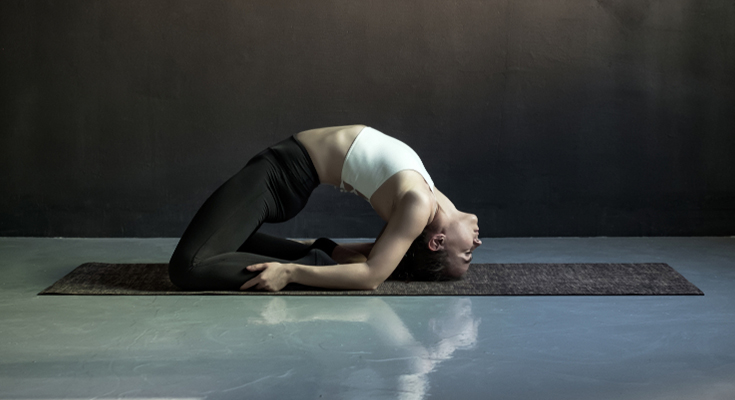Kapotasana (pigeon pose) is a bit difficult than other yoga asanas, people who are doing this for the first time might find it difficult to practise Kapotasana steps.
Therefore, today we will share some information related to the Kapotasana steps, Kapotasana benefits, and preparatory asana before you practise Kapotasana steps and the precautions related to Kapotasana yoga.
The word ‘Kapotasana’ (Pigeon pose) has derived from the Sanskrit language in which the meaning of ‘Kapot’ is ‘Pigeon’ and the meaning of ‘Asana’ is ‘Pose.’ When a person practises Kapotasana steps their body looks graceful like a bird. Not only this Kapotasana benefits your spine by giving it a nice stretch, but this also helps to strengthen your spine.
Read these instructions carefully before practising Kapotasana yoga:
- Your stomach, and bowels must be empty before you practise Kapotasana steps.
- You need to maintain a gap of at least 5 to 6 hours, between your meal and practising Kapotasana yoga (Pigeon Pose), this will help you digest all the food you had and to clean your bowels as well.
- It is advisable to practise Kapotasana steps early in the morning time because in the morning your stomach is empty and that is the best time to practise this asana.
Kapotasana Steps to practice it correctly:
- Before you practise Kapotasana steps, just assume that this is like the Ustrasana but with a twist.
- Lie down on the yoga mat, inhale and then lift the lower part of your belly towards the ceiling or sky. Move your tailbone downwards this will help you stabilize the lower back.
- While practising Kapotasana steps, make sure you pull the lower part of your belly before you raise it and then gently exhale.
- Then, you need to inhale and pull your arms and make sure that both the arms are along with your ears. If you want, you can bring your arms together.
- While practising Kapotasana steps you need to make sure that your lower back is stable and long while you are exhaling to move backwards.
- While practising Kapotasana steps, you should notice that there are no signs of strain or pain while practising Kapotasana steps and then continue further.
- After this, you need to squeeze your elbows towards each other, gently lift your shoulders and move your head back.
- Then, at this stage of Kapotasana steps, you need to hold the position for at least five breaths.
- Try to press your feet against the floor, inhale and let your arms reach the floor. After this you need to bend your knees, but only that much that you would be able to reach the palms of your hands.
- While practising Kapotasana steps, to meet your fingers meet the heels and for this, you need to walk your hands towards your knees. Once, your fingers meet the hells clutch them tightly.
- While practising Kapotasana steps, you need to squeeze the elbows towards each other and try to push your hips forward. Try to maintain the length and space of your lower back intact.
- While practising Kapotasana steps exhale and then bend your elbow to fix them on the mat.
- You need to hold this position for 30 seconds to 1 minute at least. If you can do it for more than 1 minute, it is also fine.
- Try to breathe normally while coming back to the starting position, gently roll your spine and assume the Balasana or say the child pose before coming back to the normal position.
Do not practise Kapotasana yoga (Pigeon Pose):
- Do not practise Kapotasana pose if you are suffering from insomnia, hypertension, and migraine.
- Don’t practise Kapotasana pose if you feel pain in the lumbar spine or shoulders, you need to stop practising immediately. But, if you feel completely stable and not feeling any pain or strain then you can surely continue with the Kapotasana yoga (Pigeon Pose).
- Do not practise Kapotasana pose if you are suffering from chronic back problem or injuries.
If you are suffering from any health-related issue or some pain in the various parts of your body, it is advisable to first consult your doctor before you practise Kapotasana steps or any yoga asana.
Kapotasana Benefits:
1. Kapotasana benefits your body by increasing the flexibility in your calf muscles, spine, hands, arms, shoulders, and things.
2. Kapotasana benefits your legs, joints and muscles by strengthening and stretching them.
3. This helps to tone up the muscles of the throat, including some organs like abdomen, chest and ribcage.
4. Kapotasana benefits your digestive system by enhancing the functioning of your digestive system. Kapotasana also increases the blood circulation in your body.
5. Kapotasana benefits to decrease the effects of chronic diseases and reduce blood pressure.
6. Kapotasana benefits people who are suffering from sciatica problem and strengthen your lungs.
7. This Asans helps to activate the nervous system and enhance oxygen intake.
8. It helps to decrease the stiffness in the back, hips and shoulders area.
9. Kapotasana benefits your mind and body to feel relaxed and stress-free.
10. Kapotasana yoga (Pigeon Pose) prevents you from urinary disorders.
It will be really helpful for you to read, understand, see and then practise Kapotasana steps correctly without making any mistake. This will also help you prevent injuries.

